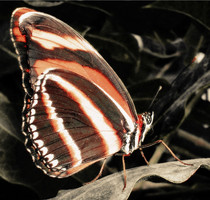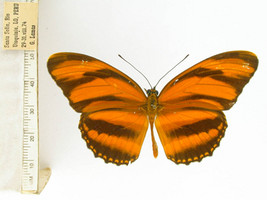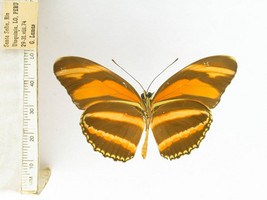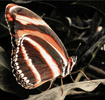Dryadula
Dryadula phaetusa
Margarita Beltrán and Andrew V. Z. BrowerIntroduction
A monotypic genus distributed throughout the continental neotropics. The genus is recognized by having shorter and broader wings than other heliconiines, comparatively short antennae, and an androconical patch in the males.
Characteristics
Early stages: Eggs are yellow and approximately 1.7 x 1.1 mm (h x w). Females place eggs singly mostly on leaves, and on the base of the stem of the host plant (Brown, 1981). The larvae are almost unicolored, spiny and gregarious feeders. Mature larvae are dull purple with many short bristly spines; head capsule dark purple with two semi-knobbed head horns (DeVries, 1997).
Habits
Dryadula is an inhabitant of disturbed areas in the lowlands, and it is hardly ever found in association with forest and occurs infrequently from sea level to 1,200 m. Sporadically found to roost gregariously at night (DeVries, 1981).
Hostplant: Dryadula larvae feed primarily on plants from the subgenus Distephana and Granadilla (Passifloraceae)(Brown, 1981). In Costa Rica larvae feed on Passiflora talamacensis (Passifloraceae) (DeVries, 1997).
References
Brown K. S. 1981 The Biology of Heliconius and Related Genera. Annual Review of Entomology 26, 427-456.
DeVries P. J. 1997 The Butterflies of Costa Rica and Their Natural History, Volume I: Papilionidae, Pieridae, Nymphalidae Princeton University Press, Baskerville, USA.
Michener CD. 1942. A generic revision of the Heliconiinae (Lepidoptera, Nymphalidae). Amer. Mus. Novit. 1197: 1-8.
Title Illustrations

| Scientific Name | Dryadula phaetusa |
|---|---|
| Specimen Condition | Live Specimen |
| Source | Bandedorange |
| Source Collection | Flickr |
| Image Use |
 This media file is licensed under the Creative Commons Attribution-NonCommercial-NoDerivs License - Version 2.0. This media file is licensed under the Creative Commons Attribution-NonCommercial-NoDerivs License - Version 2.0.
|
| Copyright | © 2006 Myrte |
| Scientific Name | Dryadula phaetusa |
|---|---|
| Specimen Condition | Dead Specimen |
| Sex | Male |
| View | dorsal |
| Collection | Gerardo Lamas |
| Image Use |
 This media file is licensed under the Creative Commons Attribution-NonCommercial-ShareAlike License - Version 3.0. This media file is licensed under the Creative Commons Attribution-NonCommercial-ShareAlike License - Version 3.0.
|
| Copyright |
©

|
| Scientific Name | Dryadula phaetusa |
|---|---|
| Specimen Condition | Dead Specimen |
| Sex | Male |
| View | ventral |
| Collection | Gerardo Lamas |
| Image Use |
 This media file is licensed under the Creative Commons Attribution-NonCommercial-ShareAlike License - Version 3.0. This media file is licensed under the Creative Commons Attribution-NonCommercial-ShareAlike License - Version 3.0.
|
| Copyright |
©

|
About This Page

University of Cambridge, Cambridge, UK

Middle Tennessee State University, Murfreesboro, Tennessee, USA
Correspondence regarding this page should be directed to Margarita Beltrán at and Andrew V. Z. Brower at
Page copyright © 2013 and
 Page: Tree of Life
Dryadula . Dryadula phaetusa .
Authored by
Margarita Beltrán and Andrew V. Z. Brower.
The TEXT of this page is licensed under the
Creative Commons Attribution-NonCommercial-ShareAlike License - Version 3.0. Note that images and other media
featured on this page are each governed by their own license, and they may or may not be available
for reuse. Click on an image or a media link to access the media data window, which provides the
relevant licensing information. For the general terms and conditions of ToL material reuse and
redistribution, please see the Tree of Life Copyright
Policies.
Page: Tree of Life
Dryadula . Dryadula phaetusa .
Authored by
Margarita Beltrán and Andrew V. Z. Brower.
The TEXT of this page is licensed under the
Creative Commons Attribution-NonCommercial-ShareAlike License - Version 3.0. Note that images and other media
featured on this page are each governed by their own license, and they may or may not be available
for reuse. Click on an image or a media link to access the media data window, which provides the
relevant licensing information. For the general terms and conditions of ToL material reuse and
redistribution, please see the Tree of Life Copyright
Policies.
- First online 21 February 2007
- Content changed 04 September 2008
Citing this page:
Beltrán, Margarita and Andrew V. Z. Brower. 2008. Dryadula . Dryadula phaetusa . Version 04 September 2008 (under construction). http://tolweb.org/Dryadula_phaetusa/70436/2008.09.04 in The Tree of Life Web Project, http://tolweb.org/












 Go to quick links
Go to quick search
Go to navigation for this section of the ToL site
Go to detailed links for the ToL site
Go to quick links
Go to quick search
Go to navigation for this section of the ToL site
Go to detailed links for the ToL site